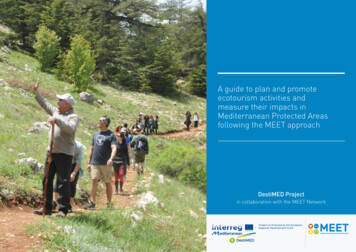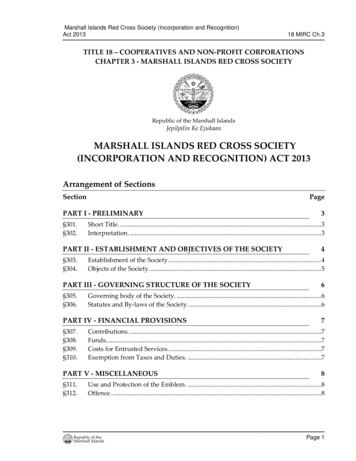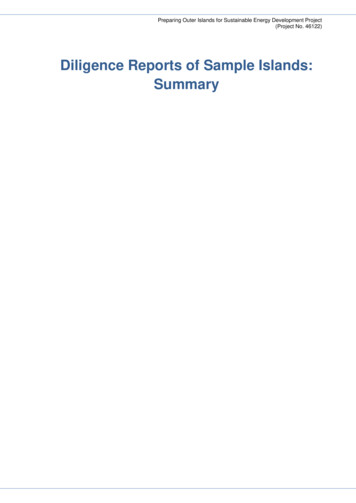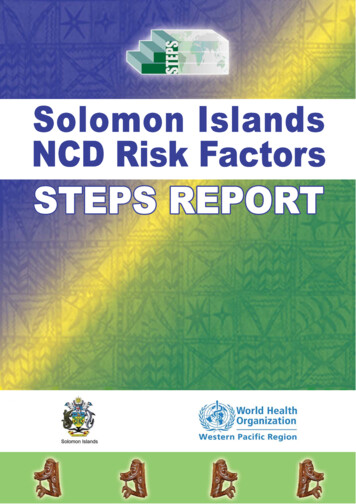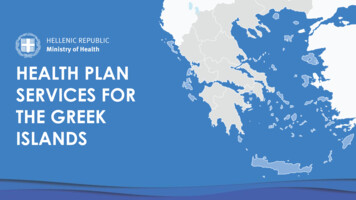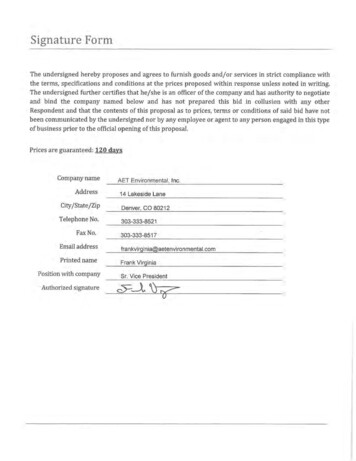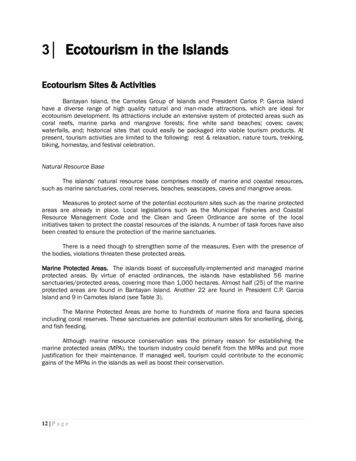
Transcription
3 Ecotourism in the IslandsEcotourism Sites & ActivitiesBantayan Island, the Camotes Group of Islands and President Carlos P. Garcia Islandhave a diverse range of high quality natural and man-made attractions, which are ideal forecotourism development. Its attractions include an extensive system of protected areas such ascoral reefs, marine parks and mangrove forests; fine white sand beaches; coves; caves;waterfalls, and; historical sites that could easily be packaged into viable tourism products. Atpresent, tourism activities are limited to the following: rest & relaxation, nature tours, trekking,biking, homestay, and festival celebration.Natural Resource BaseThe islands' natural resource base comprises mostly of marine and coastal resources,such as marine sanctuaries, coral reserves, beaches, seascapes, caves and mangrove areas.Measures to protect some of the potential ecotourism sites such as the marine protectedareas are already in place. Local legislations such as the Municipal Fisheries and CoastalResource Management Code and the Clean and Green Ordinance are some of the localinitiatives taken to protect the coastal resources of the islands. A number of task forces have alsobeen created to ensure the protection of the marine sanctuaries.There is a need though to strengthen some of the measures. Even with the presence ofthe bodies, violations threaten these protected areas.Marine Protected Areas. The islands boast of successfully-implemented and managed marineprotected areas. By virtue of enacted ordinances, the islands have established 56 marinesanctuaries/protected areas, covering more than 1,000 hectares. Almost half (25) of the marineprotected areas are found in Bantayan Island. Another 22 are found in President C.P. GarciaIsland and 9 in Camotes Island (see Table 3).The Marine Protected Areas are home to hundreds of marine flora and fauna speciesincluding coral reserves. These sanctuaries are potential ecotourism sites for snorkelling, diving,and fish feeding.Although marine resource conservation was the primary reason for establishing themarine protected areas (MPA), the tourism industry could benefit from the MPAs and put morejustification for their maintenance. If managed well, tourism could contribute to the economicgains of the MPAs in the islands as well as boost their conservation.12 P a g e
Table 3. Marine Protected Areas (MPAs) in the Camotes Group of Islands and President C.P. Garcia IslandMPALocationCovered Barangay/sTotal AreaLower Poblacion and179.2 hectaresCamotes Group of Islands1. Pilar Municipal Marine Park (PMMP)PilarVillahermosa2. Libertad Marine SanctuaryPoroLibertad33 hectares3. Esperanza Marine Protected AreaPoroEsperanza42 hectares4. Santiago MPASan FranciscoSantiago18 hectares5. San Isidro MPASan FranciscoSan Isidro48 hectares6. Esperanza MPASan FranciscoEsperanza12 hectares7. Consuelo MPASan FranciscoConsuelo38.6 hectares8. Puertobello MSTudelaPuertobello39 hectares9. Villahermosa MSTudelaVillahermosa69 hectares1. Aguining Marine SanctuaryPresident C.P.GarciaAguining51.14 hectares2. Bonbonon Marine SanctuaryPresident C.P.GarciaBonbonon32.62 hectares3. Campamanog Marine SanctuaryPresident C.P.GarciaCampamanog9.77 hectares4. Canmangao Marine SanctuaryPresident C.P.GarciaCanmangao5.35 hectares5. Kabangkalan Marine SanctuaryPresident C.P.GarciaKabangkalan2.99 hectares6. Tilmobo Marine SanctuaryPresident C.P.GarciaTilmobo2.17 hectares7. Tugas Marine SanctuaryPresident C.P.GarciaTugas10.35 hectares8. Gaus III Marine SanctuaryPresident C.P.GarciaGaus9.59 hectares9. Lipata Marine Protected Area IIPresident C.P.GarciaLipata10 hectares10. Bantigue Island Marine SanctuaryPresident C.P.GarciaButanN/A11. Bantigue-an Marine SanctuaryPresident C.P.GarciaSaguiseN/A12. Basiao Marine SanctuaryPresident C.P.GarciaBasiaoN/A13. Baud Marine SanctuaryPresident C.P.GarciaBaudN/A14. Bogo Marine SanctuaryPresident C.P.GarciaBogoN/A15. Datag Marine SanctuaryPresident C.P.GarciaPopooN/A16. Gaus I Marine SanctuaryPresident C.P.GarciaGausN/APresident Carlos P. Garcia Island13 P a g e
MPALocationCovered Barangay/sTotal Area17. Gaus II Marine SanctuaryPresident C.P.GarciaGausN/A18. Pong-Gamay Marine SanctuaryPresident C.P.GarciaLapinigN/A19. Santo Rosario Marine SanctuaryPresident C.P.GarciaSanto RosarioN/A20. Sidlakan Marine SanctuaryPresident C.P.GarciaSaguiseN/A21. Talisay Marine SanctuaryPresident C.P.GarciaPitogoN/A22. Villa Milagrosa Marine SanctuaryPresident C.P.GarciaVilla MilagrosaN/ASources: Local Government Units of Bantayan and Camotes IslandsMangroves. Several areas in the islands have been dedicated to mangrove plantations. Themore important mangrove sites are those found in Bantayan Island. The mangrove sites in theMunicipality of Madridejos cover a total area of 38.56 hectares while that in the Municipality ofBantayan cover 90 hectares. Potential activities in the area include kayaking, boating, andfishing.Beaches. The islands' coastal areas are characterized by either strips of white sand beaches orlimestone crags. Both offer good sites for swimming and seascape scenery. The islands havealso several islets thathave potential for islandhopping activities.Bantayan Islandwhere tourism is alreadyan emerging industry isparticularlypopularamong domestic andforeign visitors for itswhite and sandy beachesand clear seawaters. TheMunicipality of Santa Feboastsofa17.5kilometerstretchofpristine sandy beaches.Hence, the municipalityis host to numerousbeach resorts in theisland.Beach resort in Bantayan Island, CebuCaves. The islands havea good number of caves that are ideal for adventure tours such as spelunking.Waterfalls. Waterfalls is another attraction found in Camotes Island. The Municipality of Tudelahave two waterfalls and the Municipality of Poro has a waterfall.14 P a g e
Lakes. Lake Danao in the Municipality of San Francisco, Camotes Island is one of the mostscenic lakes in the Philippines. It is the only freshwater lake in Cebu and the second cleanestlake in the country. Given its relatively large area (approximately 500 hectares) and the fact thatno fish cage has been constructed within the lake, it could be a very good place for fishing andcruising. Lake Danao, which is home to a variety of wildlife species, is also ideal for picnics.Cultural ResourcesCultural resources include historical sites, festivals, and traditional practices.Historical Sites. The Islands of Bantayan, Camotes and President C.P. Garcia are not only hometo many natural attractions but also host a number of historical sites. An assessment of thesesites, however, needs to be conducted to determine the extent of their potential as ecotourismproducts.Festivals.Festivalsarecommon attractions in thePhilippines that showcase thecultural heritage of the locals.As these festivals were able toattract tourists in many areas,they could also be used in thecase of the islands to promotetourism.Cultural Practices.Somehandicraft industries are uniqueto the islands that could bedeveloped to become theislands' niche market in culturaltourism. Such type of tourismproduct, which couldbedeveloped further to allowtourists to personally experiencethe actual production, is gainingpopularity in the global tourismscene.Soli-soli Festival of San Francisco, Camotes Island, Cebu(Photo by Enrico Dee)15 P a g e
Ecotourism Facilities & ServicesAccommodation. Considering that the tourism industry in the islands (except Bantayan Island) isstill in its early stage of development, facilities to support the industry are limited in terms ofcapacity and type. Most of the ecotourism sites are still largely without accommodation facilities.In President C.P. Garcia Island, which is the least developed among the 3 island groups,there are only two beach resorts that provide accommodation. These resorts are quite small,capable of hosting a total of 22 guests.In Camotes Island where tourism is slowly being developed, only about 100 rooms areavailable in the entire island. Homestays, however, have been organized in some municipalitiesto address the lack of accommodation facilities in the area.In Bantayan Island where tourism is already an emerging industry, accommodationfacilities are available for tourists in all the three municipalities. Most of the hotels, resorts andrestaurants, however, are concentrated in the Municipality of Santa Fe where the best beachesare found. Among the tourist accommodation facilities in Santa Fe are six (6) class A resorts,eight (8) class B and C resorts, and 18 rest houses or cottages built along the shoreline.Accommodation is not the only facility that needs to be put up if the islands are to bedeveloped into world-class ecotourism destinations. Adequate auxiliary facilities and servicessuch as rescue and medical facilities & services, banks, tour and transport services, restaurantsand entertainment facilities, reception/information centers, and public restrooms must also beprovided.Dining. Among the three groups of islands, Bantayan Island has the most number of diningplaces and entertainment facilities for tourists. Many of these are located within the premises ofthe resorts/ hotels. Camotes Island, for its part, has limited choices of restaurants andentertainment facilities. President C.P. Garcia has no such facilities for tourists.Reception/ information centers are not available within the tourism sites.Medical Services. In Camotes Island, there is only one 25-bed capacity hospital based in theMunicipality of San Francisco. Likewise, in President C.P. Garcia Island, there is a 10-bed capacityhospital. All of the municipalities in the 3 island groups, however, have rural health units (RHU)that are staffed with a doctor, nurses, and midwives.The health care services offered in the RHUs are limited to general consultations. Forextreme medical cases, patients are usually brought to hospitals in mainland Cebu or Bohol,which are better equipped to handle more complicated medical cases.Organized professional and volunteer rescue services within the islands are non-existent.The local government units through their Barangay and Municipal Disaster Risk ReductionManagement Councils (B/MDRRMC) spearhead rescue operations during emergencies andcalamities. While the barangay volunteers have undergone short trainings on rescue anddisaster risk reduction, there is a need to hone their capabilities further to conduct rescueoperations. Providing support to the barangay volunteers and civilians is the Philippine NationalPolice.16 P a g e
Banking. Banking services, which are among the basic services expected in tourist destinations,are wanting in Camotes and President C.P. Garcia Island. There is only one bank in CamotesIsland situated in the Municipality of Poro. The bank, however, provides automatic teller machine(ATM) services; hence, certain bank transactions may be availed even beyond banking hours.In Bantayan Island, banking services are more plentiful compared to that in the otherislands. Allied Bank, Aspac, and the Bantayan Rural Bank have branches in the island. Financialservices are also available through the Western Union, Palawan Pawnshop, and several moneychanger outlets.Transportation. Tour and transport services in the islands are very much lacking. The Island ofPresident C.P. Garcia where tourism is still undeveloped has no such service for tourists. InCamotes Island, there is no locally-based tour operator to service the needs of tourists visitingthe islands. The developing tourism industry in Camotes Island relies on tour operators based inmainland Cebu to service the tourists who visit the island.Inland transportation in the Islands of Camotes and President C.P. Garcia are limited anduncomfortable. The public utility motorcycle, known locally as “habal-habal”, is the main mode oftransportation within the islands. Although the habal-habal can carry only two to three adultpassengers, it can reach any point in the islands. A few public utility jeepneys also ply certainroutes in Camotes Island especially those routes that cut across municipalities. The trips howeverare not regular and are far in-between. In contrast, Bantayan Island has a fairly developedtransportation system. Public utility jeepneys, for-hire vehicles, tricyles, habal-habal and trisikadsare plentiful to service the transportation needs of the populace.In the case of inter-island travel particularly between the islands and mainland Cebu orBohol, sea transport is the main if not sole mode of transportation. Although an airstrip, whichcan accommodate small airplanes is present in Camotes Island (Municipality of San Francisco)and Bantayan Island (Municipality of Santa Fe), only chartered flights are serviced by theairstrips. Travel time from Mactan, Cebu to Bantayan Island is approximately 30 minutes.Motorized bancas, ferryboats and fast crafts are available daily to transport passengersand cargo by sea to and from the islands to mainland Cebu or Bohol. Travel time from CamotesIsland to Danao (Cebu), Mandaue or Cebu City is approximately 3 to 4 hours in the case ofmotorized bancas or ferryboats, and 2 hours in the case of fast crafts (Cebu City to CamotesIsland). There are also boats plying the Ormoc (Leyte) – Tudela (Camotes Island) route.Bantayan Island, for its part, can be reached through an overnight sea trip by ferryboatfrom Cebu City. The traveler has also an option to take the 3-hour bus ride from Cebu City to thenorth of Cebu, to the Municipality of San Remegio and from there catch the ferryboat for the onehour trip to the island. Boat trips are also available between Bantayan Island and Masbate. In thecase of the Island of President C.P. Garcia, motorized bancas ply daily the President C.P. Garcia Ubay (Bohol) route, President C.P. Garcia - Lo-oc, Mandaue City (Cebu) route, and President C.P.Garcia – Bato (Leyte) route.Since sea travel is the only means for common travelers to reach the islands, accessibilityis a major issue in the efforts of the local governments to develop the islands' ecotourismindustry. Sea travel is affected by seasonal weather conditions. The Amihan (northeasterlywinds) which occurs from October to February usually brings high sea waves that could make seatravel uncomfortable to passengers.17 P a g e
Ecotourism StakeholdersThe ecotourism industry has a wide variety of stakeholders. They include the nationalgovernment, local governments, non-government organizations, and private enterprise operators.The following are the roles performed by the major stakeholders.National Government. On 17 June 1999, the national government passed Executive Order No.111 declaring as a policy the development of ecotourism in the Philippines. Following thisdeclaration, the national government through the various government agencies coordinated thepreparation of tourism development plans and the conduct of tourism promotional activities.The National Ecotourism Strategy for the Philippines (July 2002) and the SustainableTourism Management Plan for the Central Philippines (December 2007) have identified anumber of sites in Bantayan Island and the Camotes Group of Islands as potential keyecotourism sites in the country and batted for their development. The recognition of CamotesIsland as an emerging important tourist destination in the country was especially reaffirmed bythe national government when it named the island as the “new iconic product” in CentralVisayas. With the inclusion of Bantayan and Camotes Islands in the national government's plansfor ecotourism development, marketing them as major ecotourism destinations should not be asmuch a problem. In the case of President C.P. Garcia Island in Bohol, while the islandmunicipality is not specifically mentioned as a key ecotourism site in the country's tourism plans,the whole province of Bohol is recognized as an important ecotourism destination which can alsobenefit President C.P. Garcia Island.The Department of Tourism (DOT) is coordinating the development and governmentmarketing of the ecotourism sites and products of the Philippines, the Central Visayas Islandsincluded. DOT is also involved in standard setting for the industry.Aside from policy setting and promoting the ecotourism sites, the national government isin the forefront of protecting the natural and cultural resources of the country. In particular, theDepartment of Environment and Natural Resources (DENR) together with the Protected AreaManagement Boards (PAMBs) oversee the development and management of the protected areasof which the small islands are critical components. As protected areas, no development isallowed to be undertaken in these areas unless approved by DENR and the PAMBs.Among the more recent initiatives of the national government to develop and promoteecotourism in the small islands of Central Visayas was the implementation of the PhilippineEnvironmental Governance Project or eGov Project. The eGov Project, a technical assistanceproject of the United States Agency for International Development (USAID), facilitated theformulation of the Destination Development Plan for the Camotes Sea. The plan provides a broadframework for the development of the Camotes Group of Islands as an ecotourism destination.The assistance of the national government especially DOT and DENR in developing theislands' ecotourism industry continues to be needed particularly in the following areas: capacitybuilding for the local government units on ecotourism planning, product development, standardssetting, monitoring and administration of ecotourism activities; and enforcement of laws, rulesand regulations that have bearing on ecotourism.18 P a g e
Local Government. The policy of the national government to promote ecotourism spurred thelocal government units of Bantayan and Camotes Islands to assess potential ecotourismdestinations within their respective localities and to take the lead in developing and marketingsome of these ecotourism sites. Thus far, Bantayan Island has the most developed tourismindustry among the three island groups. In contrast, the municipal government of President C.P.Garcia has yet to take an active role in developing the ecotourism industry of the island. Theseinclude the identification of potential ecotourism destinations/sites, the preparation of plans,product development, marketing, infrastructure development and social and communitymobilization.The municipal governments were assisted in marketing the ecotourism products of theislands by the provincial government and the private sector. The Suroy-Suroy Sugbu tours of theCebu Provincial Government in particular had been providing the venue for Bantayan andCamotes Islands to showcase their potential as important ecotourism destinations. This tourismproject involves 3-day visits to a number of towns to experience the lifestyle and culture of thearea. Part of the program includes visits to cultural heritages like old churches, culturalpresentations/shows, food fairs of local delicacies, exhibits of crafts and other products, andvisits to natural attractions. A fee is charged from participants to cover accommodation and othertravelling costs. Thus far, the tours were successfully in attracting a number of tourists thatincluded balikbayans, domestic and foreign tourists, and businessmen. The Cebu ProvincialGovernment has been receiving inquiries on future Suroy-Suroy Sugbu tours, an indication of itsincreasing popularity, which could benefit Bantayan and Camotes abogonAlegriaCarcarOslobRondaBantayanSan RemigioSamboanSanta FeMadridejosGinatilanDanao City CompostelaSuroy-Suroy Sugbo Program of Cebu Province19 P a g e
The local government especially the municipal government is also deeply involved inenvironment protection. The numerous marine protected areas and marine sanctuaries, for one,were created by the local government units through local legislation. Aside from passing localordinances, the local governments created councils, task forces and similar bodies (e.g., CoastalLaw Enforcement Council, Task Force Kalikupan, Bantay Dagat) to oversee the management anddevelopment of the natural resources of the islands and the implementation of measures,regulations and standards set by the national and local governments.The local government units partnered with the private sector and the non-governmentorganizations in many of the tourism-related activities of the LGUs. The Expanded-GreenWholesome Environment that Nurtures or e-GWEN program of the Provincial Government ofCebu, for instance, is being implemented in cooperation with the Ramon Aboitiz Foundation Inc.(RAFI). The e-GWEN program assists the local government units in Cebu practice goodgovernance, environmental protection, and sustainable ecotourism development and promotion.The LGUs are expected to continue to provide direction for ecotourism at the local leveland to ensure that ecotourism in the local area contributes to the protection of the natural andcultural resources of the area.Protected Area Management Board. Since Bantayan Island, the Camotes Group of Islands, andthe Island of President C.P. Garcia are declared protected areas (as many of the small islands ofCentral Visayas are), the Protected Area Management Boards (PAMBs) composed ofrepresentatives of national agencies, local government units and non-government organizationsare responsible for planning and overseeing the development and management of the islands.As protected areas, no development is allowed to be undertaken in these areas unless approvedby the PAMBs.The PAMBs of the three island groups have been organized and are involved in thefollowing: policy formulation, settlements regulation, issuance of occupancy rights, collection andmanagement of user's fees, royalty fees and other fees, and issuance of clearances inshorelines.Non-Government Organizations. There are non-government organizations or NGOs implementingecotourism-related projects in the islands. Most of the projects involve natural resourcepreservation and management. Livelihood assistance is also being provided by some NGOs. Thebeneficiaries of the projects of NGOs include small-scale fishermen and farmers, and women.Tourism Enterprises. Tourism enterprises pertain to facilities, services and attractions involvedin tourism (Republic Act 9593, 2009). They include the following: travel and tour services, touristtransport service, accommodation establishments, convention and exhibition organizers, tourismestate management services, restaurants, shops/stores, recreational centers, spas, museums/galleries, theme parks, and convention centers.Among the three island groups, Bantayan Island has the most number and variety oftourism enterprises. Camotes Island's tourism enterprises, which are few, consist mainly ofaccommodation facilities and eateries. The Island of President C.P. Garcia has only two beachresort establishments and no other tourism enterprise.20 P a g e
The tourism enterprises in the three islands are not organized. That is, eachestablishment work individually to advance its interests or business. This fragmented action oftourism enterprises makes it difficult to raise awareness and generate action on common issuesand concerns plaguing the tourism enterprises in the islands.The lack of properly trained and educated manpower to work in the islands' tourismenterprises as well as lack of knowledge on product development are also major challenges.Thus, capability building programs and skills trainings are some of the priority activities that needto be implemented in the short-term for the tourism enterprises for a sustainable ecotourism.Visitors. Visitors seeking ecotourism experiences are the very reason why there is an ecotourismmarket. At present, only a small segment of this growing market has been tapped by the threeisland groups mainly because of limited products that the islands could offer for the moment.With their natural resources and cultural assets, the islands have the potential to attractthe following types of market: adventure travellers, sedentary travellers, families, scuba divers,independent travellers or backpackers, resort-centric travellers, students, and study tours. Theislands have also potentials as sites for film-making, art tours, and photography.As travellers become more discerning --- seeking quality experiences and willing to paywell for them --- it is essential that tourism authorities strive to come up with quality ecotourismproducts. Satisfied visitors could be very effective tourism marketing agents for the islands'ecotourism destinations.Local Communities. In order to maximise the benefits that ecotourism could bring to thecommunities, the local populace must be involved in ecotourism planning processes andactivities. The sustainability of ecotourism depends largely on the support of the localcommunity. Local communities will be more inclined to support and champion the ecotourismprojects and activities if they are made part of the planning for these activities.The success of the islands in their implementation of past community-based initiatives isan indication that ecotourism, which is anchored on community-based tourism, could be a viablelong-term undertaking in the islands.21 P a g e
Table 4. Major Stakeholders and their Roles in Ecotourism DevelopmentStakeholderRoles/Major Areas of InterestNational Government AgenciesDepartment of Environment and NaturalResources (DENR)Conservation of biodiversity, management ofprotected areas under NIPAS, establishment &management of critical habitats, hazardmitigation, policies, plans & programs formulationon environmental concerns, promulgation ofrules, regulations & guidelines, enforcement ofenvironmental lawsDepartment of Agriculture (DA)Well-being of fishermen, conservation & properutilization of fishery & aquatic resources, policyformulation, conduct of trainingDepartment of Interior and Local GovernmentConduct of training/capability building of LGUsDepartment of Transportation andCommunication (DOTC)Policy formulation and regulation of marinetransport and communicationPhilippine Ports Authority (PPA)Ports development and managementDepartment of Public Works and Highways(DPWH)Public works/ infrastructure development (e.g.roads)Department of Trade and Industry (DTI)Trade, livelihood development and trainingDepartment of Tourism (DOT)Tourism development, production of IECmaterials, promotions and marketing, policyformulationTechnical Education and Skills DevelopmentAuthority (TESDA)Skills trainingLocal Government UnitsEnforcement of laws, legislation of local laws toregulate natural resource utilization anddevelopment, enactment of comprehensive landuse plans & zoning ordinances, preparation oflocal tourism/destination plans, development andpromotion of ecotourism sites, funding andimplementation of programs & projectsProtected Area Management Board (PAMB)Management of protected areasNon-government Organizations (NGOs)Conduct of skills training, livelihood developmentand training, conservation of biodiversityTourism EnterprisesDevelopment and promotion of ecotourism sitesand products, provision of ecotourism services,conservation of natural resources22 P a g e
StakeholderRoles/Major Areas of InterestVisitors/ TouristsPromotion of ecotourism sites and products,contribution to conservation of naturalenvironmentLocal CommunitiesPlans and programs formulation, developmentand promotion of ecotourism sites, monitoring ofimplementation of environmental lawsSupport Infrastructure and UtilitiesThe presence of good infrastructure and reliable utility services are pre-conditions to asuccessful and sustainable ecotourism industry. The following sections describe briefly the stateof the infrastructure and utilities in the three island groups.Sea Ports. The existing seaports in the three island groups are used primarily by the ordinarycommuters in their trips to or out of the islands. The same seaports are used by the tourists whovisit the islands. Most of the trips going to or originating from the islands' seaports havemainland Cebu (for Bantayan and Camotes Islands) and mainland Bohol (for President C.P.Garcia) as their destinations. There are also trips going to other neighboring provinces such asLeyte and Masbate (see Figure 2).Camotes Group of Island. Camotes Island has port facilities in the Municipalities of Poro, SanFrancisco, Tudela and Pilar. The ports cater mainly to small boats plying mainland Cebu andCamotes, and Leyte and Camotes. There is also a fastcraft service plying the Cebu City to Pororoute. In the Port of Poro, there are plans to put up a shopping center inside the port to cater topassengers as well as tourists.President Carlos P. Garcia Island. The island municipality has one base port, the Port of Pitogo,and 2 subsidiary feeder ports in Barangays Popoo and Aguining. The Port of Pitogo is the mainport of the island and the town’s gateway to Cebu and mainland Bohol. While the Port of Pitogois not designed for large seacrafts, large vessels can drop anchor in Pitogo Bay. The Port ofPitogo, however, has no passenger terminal facilities but only a waiting shed that provides littleshelter to passengers.The feeder port in Barangay Popoo has RORO facilities. Motorized bancas however arethe main users of the port. These bancas are available anytime to transport passengers from theisland to Ubay in mainland Bohol and vise-versa for a fee with special night rates. Travel time isonly 10 minutes. As in the case of the Pitogo port, the Popoo feeder port has no passengerterminal facilities but only a waiting shed.The feeder port in Barangay Aguining is operational on Fridays only. Except for a concretequay, it has no other facilities. The Port of Aguining serves mainly as jump off point for thetransport of livestock bound for Maasin City in Southern Leyte.23
MPA Location Covered Barangay/s Total Area Camotes Group of Islands 1. Pilar Municipal Marine Park (PMMP) Pilar Lower Poblacion and Villahermosa 179.2 hectares 2. Libertad Marine Sanctuary Poro Libertad 33 hectares 3. Esperanza Marine Protected Area Poro Esperanza 42 hectares 4. Santiago MPA San Francisco Santiago 18 hectares 5.


